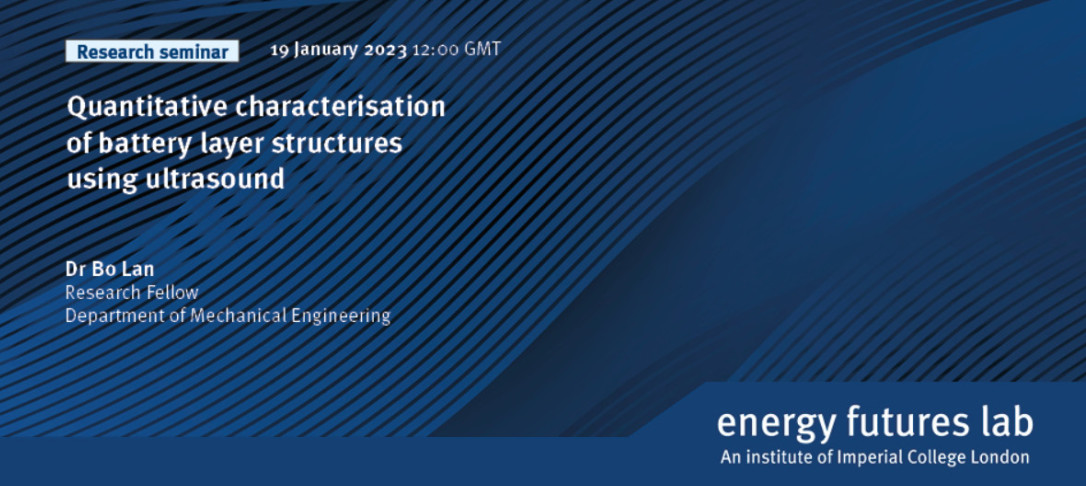
Quantative characterisation of battery layer structures using ultrasound
This talk covers two main research topics on ultrasonic characterisation of battery structures that we, at the Non-Destructive Evaluation group are conducting.
The first topic is about quantitative measurement of tortuosity and porosity of the porous electrodes using air-coupled ultrasound. We utilise the fundamental fact that in a porous material with a rigid frame (i.e. the electrode sheets in air), there exists a slow Biot wave mode which only travels in the gaseous phase, through the same tortuous pathway that ions diffuse through in a live battery. This enables quantitative extraction of porosity and tortuosity from simple, real-time ultrasonic testing of the electrode layers during manufacturing. To achieve this, we have developed a wave physics model that describes the propagation of the Biot waves in porous multilayers; it takes account of the complex boundary conditions across the solid-porous interfaces and delivers optimal computing efficiency. The model is being employed to perform a thorough, multivariant search for the ideal experimental configurations, for the objective of quantitative inversion of these desirable parameters.
The second topic reports an exciting methodology for quantitatively characterising the internal layered structure of LIBs using ultrasonic resonance. This work first employs simple, conventional ultrasound equipment to experimentally acquire resonant signals from batteries. Then it establishes a new theoretical model, to explain the physical principles of how resonance forms from layer reflections, and how to retrieve various crucial information about battery inner structures from the resonant signals. Finally, to showcase the capabilities of the new methodology, we demonstrate that the technique is successful in recovering the number of repetitive layers, the average thicknesses of anode and cathode coating layers, a spatially resolved image of internal layers in the depth direction, and the state of charge (SOC) with layer-to-layer resolutions.
Biography:
Dr Bo Lan is an Imperial College Research Fellow based at the Non-Destructive Evaluation (NDE) group of the Mechanical Engineering Department. He earned his PhD in 2015 from University of Oxford, and was a Postdoctoral Research Associate (PDRA) at the NDE group in Imperial until the award of the Fellowship in 2019. He has developed leading expertise on the interfacial area between materials science and NDE. This came into fruition as the invention of a general methodology that achieved, for the first time, high-fidelity recovery of volumetric texture from ultrasonic wave speeds. This research area has attracted > £1.2M funding from EPSRC and industries. He is currently leading the group’s efforts on the ultrasonic characterisation of batteries, from the manufacturing processes, to in-service monitoring, all the way to recycling.
About Energy Futures Lab
Energy Futures Lab is one of seven Global Institutes at Imperial College London. The institute was established to address global energy challenges by identifying and leading new opportunities to serve industry, government and society at large through high quality research, evidence and advocacy for positive change. The institute aims to promote energy innovation and advance systemic solutions for a sustainable energy future by bringing together the science, engineering and policy expertise at Imperial and fostering collaboration with a wide variety of external partners.